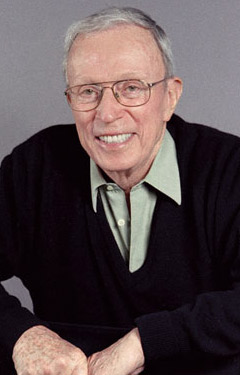BY JESSE HIESTAND

(Photo Credit: DGA Archives)
As Jack Shea strolls through the executive floor of the DGA headquarters, portraits of honored members catch his attention like old friends, as many of them have been. He pauses by the Robert E. Wise Library, which he dedicated to the legendary director nearly a decade ago. These are hallowed halls for a past president, and Shea continues to share a special bond with the Guild. It’s been five years since he left office, but it’s as though it were yesterday. “I haven’t been up here in awhile,” Shea smiles, “but I certainly remember my way around.”
Shea, who turns 80 next year, culminated his nearly 50 years commitment to the Guild by serving as president from 1997-2002. He dedicated himself to getting other members—women, minorities, and all members of the directorial team East and West—to serve on Guild Councils and Boards, fostering a greater sense of national unity and ensuring that the DGA remained firmly in the members’ hands.
Now retired from Guild service, and with a full career as a director, associate director and stage manager behind him, Shea embodies a remarkable stretch of DGA history.
Growing up in Manhattan, Shea developed an early love of show business. He started working as a stage manager at NBC in 1950 and helped his co-workers organize the Radio and Television Directors Guild (RTDG). Within a year, they had achieved a union shop where anyone on the directorial staff could join the new guild for a $50 initiation fee. “I saw that there were people who were being eaten up because they didn’t have any kind of labor organization to protect them,” he says.
Shea served two years in the Air Force as a television director doing educational films, including one he still laughs about—how to brush your teeth. Within months of his return, NBC offered him a job in its Hollywood studio. It was 1954 and he was one of the few leaders of the relatively small, New York-based RTDG working in Los Angeles.
“I was president of the RTDG for a while, and we knew we had no money and were just representing people in television,” says Shea. “We knew that there was this big guild out there—the Screen Directors [Guild]—and several of us got the idea that we should get together. Some people really fought it because they thought we’d get gobbled up. And the other side was a little reluctant because we were just a bunch of pipsqueaks. We had a few battles, mostly on our side, to get everybody to do it and I think the merger was a marvelous success.”
Shea’s dedication to the Guild led him to serve for 35 years on the Directors Council and National Board, as chair of the Negotiating Committee, vice president, secretary-treasurer, and a member of numerous other committees. For his commitment, Shea received the Robert B. Aldrich Achievement Award for extraordinary service to the Guild in 1992.
The pinnacle of his service came as DGA president, when he tackled several issues that remain priorities today. Under his watch, the Guild took action on runaway production, encouraged diversity in hiring, formed an Independent Directors Committee, and negotiated landmark deals, including the historic “blended contract” agreement. He sought greater participation by professionally active members through the work in trade amendment, and was instrumental in expanding the Guild’s New York operations and overseeing a major renovation of its facilities.
Shea admits it was challenging to maintain a career and devote decades to Guild service. But it kept him grounded in the reality of working film and television directors, and, he thinks, enabled him to be a more effective leader. “The fact that we were active, working directors helped [the committee] a lot in negotiations because we knew what we needed to do for members—and that was always to give our people a better shot."